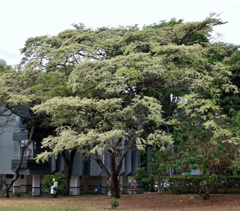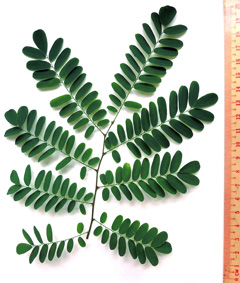 |
|
https://edibleplants.org/ |
 |
| https://edibleplants.org/ |
Translate this page:
Summary
Other common names are Bahia Rosewood, Jacaranda da Bahia, Rio Rosewood, Piano wood, Cabiuna, and Obuina. Found in South America, Brazilian Rosewood or Dalbergia nigra is a popular timber species used in high grade furniture and musical instruments especially pianos. It can also be used as ornamental tree and as pioneer species in restoring agroforestry. It is highly resistant to insect attacks. The wood is rose-scented, very heavy, and highly durable. It is considered as vulnerable species on the international IUCN Red List.
Physical Characteristics

 Dalbergia nigra is a deciduous Tree growing to 20 m (65ft) by 20 m (65ft) at a medium rate.
Dalbergia nigra is a deciduous Tree growing to 20 m (65ft) by 20 m (65ft) at a medium rate.
See above for USDA hardiness. It is hardy to UK zone 10. The flowers are pollinated by Insects.
It can fix Nitrogen.
Suitable for: light (sandy), medium (loamy) and heavy (clay) soils, prefers well-drained soil and can grow in nutritionally poor soil. Suitable pH: mildly acid, neutral and basic (mildly alkaline) soils. It cannot grow in the shade. It prefers dry or moist soil and can tolerate drought.
UK Hardiness Map
US Hardiness Map
Synonyms
Amerimnon nigrum (Vell.) Kuntze Pterocarpus niger Vell.
Plant Habitats
Edible Uses
References More on Edible Uses
Medicinal Uses
Plants For A Future can not take any responsibility for any adverse effects from the use of plants. Always seek advice from a professional before using a plant medicinally.
None known
References More on Medicinal Uses
The Bookshop: Edible Plant Books
Our Latest books on Perennial Plants For Food Forests and Permaculture Gardens in paperback or digital formats.

Edible Tropical Plants
Food Forest Plants for Hotter Conditions: 250+ Plants For Tropical Food Forests & Permaculture Gardens.
More

Edible Temperate Plants
Plants for Your Food Forest: 500 Plants for Temperate Food Forests & Permaculture Gardens.
More

More Books
PFAF have eight books available in paperback and digital formats. Browse the shop for more information.
Shop Now
Other Uses
Furniture Wood
Agroforestry Uses: Although fairly slow growing, the tree is suitable for use in reforestation programmes within its native range, and is especially suited for use where the soil is dry[ 419 ]. Other Uses: A very decorative and valuable wood that varies in colour from brown to chocolate brown or violet, streaked with black[ 46 ]. It is rose-scented; straight grained; medium texture; very heavy; of high natural durability and has excellent working qualities[ 46 ]. It is used for cabinet work, is particularly valued for pianos, luxury furniture, handles of fine tools, marquetry, billiard tables etc[ 46 , 419 ].
Special Uses
Nitrogen Fixer
References More on Other Uses
Cultivation details
Prefers a sunny position[ 419 ]. Succeeds in dry soils[ 419 ]. Established plants are drought tolerant[ 419 ]. The plant has a moderate rate of growth[ 419 ]. This species has a symbiotic relationship with certain soil bacteria, these bacteria form nodules on the roots and fix atmospheric nitrogen. Some of this nitrogen is utilized by the growing plant but some can also be used by other plants growing nearby[ 755 ].
References Carbon Farming Information and Carbon Sequestration Information
Temperature Converter
Type a value in the Celsius field to convert the value to Fahrenheit:
Fahrenheit:
The PFAF Bookshop
Plants For A Future have a number of books available in paperback and digital form. Book titles include Edible Plants, Edible Perennials, Edible Trees,Edible Shrubs, Woodland Gardening, and Temperate Food Forest Plants. Our new book is Food Forest Plants For Hotter Conditions (Tropical and Sub-Tropical).
Shop Now
Plant Propagation
Seed - best sown as soon as it is ripe in a semi-shaded position in a nursery seedbed. A germination rate in excess of 80% can be expected, with the seeds sprouting within 10 - 20 days[ 419 ]. Seedlings develop slowly, but should be ready to plant out within 6 - 7 months[ 419 ]. Like many species within the family Fabaceae, once they have been dried for storage the seeds of this species may benefit from scarification before sowing in order to speed up germination. This can usually be done by pouring a small amount of nearly boiling water on the seeds (being careful not to cook them!) and then soaking them for 12 - 24 hours in warm water. By this time they should have imbibed moisture and swollen - if they have not, then carefully make a nick in the seedcoat (being careful not to damage the embryo) and soak for a further 12 hours before sowing[ K ].
Other Names
If available other names are mentioned here
bahia rosewood, brazilian rosewood, cabiúna-rajada, caviúna, jacaranda, jacarandá-cabiúna, jacarandá-caviúna, jacarandá-da-bahia, jacarandá-preto, jacarandá-roxo, jacarandá-una, palisandre, palisandro del brazil, rio rosewood, rosewood (brazilian)
Native Plant Search
Search over 900 plants ideal for food forests and permaculture gardens. Filter to search native plants to your area. The plants selected are the plants in our book 'Plants For Your Food Forest: 500 Plants for Temperate Food Forests and Permaculture Gardens, as well as plants chosen for our forthcoming related books for Tropical/Hot Wet Climates and Mediterranean/Hot Dry Climates. Native Plant Search
Found In
Countries where the plant has been found are listed here if the information is available
Brazil
Weed Potential
Right plant wrong place. We are currently updating this section.
Please note that a plant may be invasive in one area but may not in your area so it’s worth checking.
Conservation Status
IUCN Red List of Threatened Plants Status : Status: Vulnerable A1cd

| Related Plants
|
| Latin Name | Common Name | Habit | Height | Hardiness | Growth | Soil | Shade | Moisture | Edible | Medicinal | Other |
| Dalbergia baronii | Palissandre rouge des marais, hitsika, sovodrano | Tree | 20.0 |
10-12
| M | LM | N | Mwe | 0 | 0 | 4 |
| Dalbergia cochinchinensis | Siam Rosewood, Thailand Rosewood | Tree | 25.0 |
10-12
| S | LMH | N | M | 0 | 0 | 4 |
| Dalbergia greveana | Madagascar Rosewood | Tree | 15.0 |
10-12
| S | LMH | N | DM | 0 | 2 | 4 |
| Dalbergia hupeana | | Tree | 15.0 |
-
| | LMH | SN | M | 1 | 1 | 3 |
| Dalbergia latifolia | Black Rosewood, East Indian Rosewood, Kala sheeshan, Satisal | Tree | 30.0 |
10-12
| M | LMH | N | M | 0 | 2 | 4 |
| Dalbergia louvelii | Andramena, Volombodipona, Violet rosewood | Tree | 15.0 |
10-12
| M | LMH | N | M | 0 | 2 | 4 |
| Dalbergia melanoxylon | African Blackwood, Grenadilla, Mpingo | Tree | 6.0 |
10-12
| S | LMH | N | DM | 0 | 2 | 5 |
| Dalbergia monticola | Hazovola, tsiandalana, voamboana | Tree | 12.0 |
10-12
| S | LMH | N | M | 0 | 0 | 4 |
| Dalbergia oliveri | Redwood | Tree | 23.0 |
10-12
| S | LMH | SN | M | 0 | 0 | 4 |
| Dalbergia retusa | Cocobolo | Tree | 20.0 |
10-12
| S | LMH | N | M | 0 | 0 | 4 |
| Dalbergia stevensonii | Honduras Rosewood | Tree | 20.0 |
10-12
| S | LMH | N | M | 0 | 0 | 4 |
|
Growth: S = slow M = medium F = fast. Soil: L = light (sandy) M = medium H = heavy (clay). pH: A = acid N = neutral B = basic (alkaline). Shade: F = full shade S = semi-shade N = no shade. Moisture: D = dry M = Moist We = wet Wa = water.

Expert comment
Author
(Vell.) Allem?o ex Benth.
Botanical References
Links / References
For a list of references used on this page please go here
A special thanks to Ken Fern for some of the information used on this page.
Readers comment
| Add a comment |
|
If you have important information about this plant that may help other users please add a comment or link below. Only comments or links that are felt to be directly relevant to a plant will be included. If you think a comment/link or information contained on this page is inaccurate or misleading we would welcome your feedback at [email protected]. If you have questions about a plant please use the Forum on this website as we do not have the resources to answer questions ourselves.
* Please note: the comments by website users are not necessarily those held by PFAF and may give misleading or inaccurate information.
To leave a comment please Register or login here All comments need to be approved so will not appear immediately.
|
Subject : Dalbergia nigra
|
|
|
|